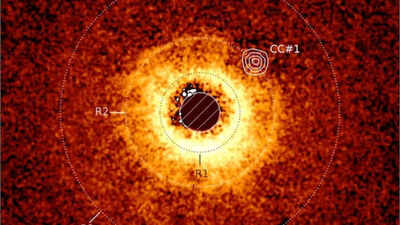The James Webb Space Telescope (JWST) has achieved a milestone, directly imaging its first new planet after dedicating three years to exoplanet research. The newly discovered exoplanet, named TWA 7b, is a young, low-mass world orbiting a young star 111 light-years away.

An artist's rendition depicts the groundbreaking discovery of TWA 7b by the James Webb Space Telescope.
TWA 7b is the lowest-mass planet ever directly imaged outside our solar system. It has a mass approximately 0.3 times that of Jupiter or 100 times that of Earth, making it ten times lighter than any previously directly imaged exoplanet.
The exoplanet orbits CE Antliae (TWA 7), a young, low-mass star in the constellation Antlia, about 111 light-years from Earth. CE Antliae, part of the TW Hydrae Association, is estimated to be only 6.4 million years old, a cosmic infant compared to our 4.6-billion-year-old Sun. Its youth and orientation make it perfect for JWST imaging.
The discovery of TWA 7b hinged on infrared imaging, a specialty of the JWST. Young, low-mass planets emit thermal radiation in the infrared spectrum. The telescope's Mid-Infrared Instrument (MIRI) and coronagraph were crucial.
A coronagraph blocks the overwhelming light of a star, enabling the detection of faint nearby objects like exoplanets. The JWST team detected a faint infrared source embedded in the debris disc around TWA 7 using high-contrast imaging.
This faint source resided in a gap between dust rings, an area expected to be carved out by a planet's gravitational influence. Simulations validated that a Saturn-mass planet in that location could explain the observed structure.
The disc around TWA 7 contains three distinct rings separated by gaps. One gap features a narrow ring flanked by dust-free regions, a hallmark of an orbiting planet's gravitational forces. The infrared glow detected by JWST aligns precisely with this ring gap. Its brightness, temperature (around 320 Kelvin or 47°C), and orbital distance (about 50 astronomical units from the star) match expectations for a planet in this region.
The discovery of TWA 7b is a major step forward in exoplanet science for several key reasons:
Astronomers believe debris discs around young stars are blueprints for planetary formation. The rings and gaps represent zones where material accumulates to form planets or is cleared by their gravity. TWA 7b may be the first direct evidence of this process.
Researchers used advanced image subtraction methods to detect TWA 7b. By removing residual starlight, they could distinguish the planet from other celestial objects. This finding demonstrates how new observing methods and instruments on JWST, like the coronagraph and MIRI, are expanding our ability to discover previously inaccessible exoplanets. JWST's mid-infrared sensitivity now allows it to detect planets as massive and cold as Saturn, a significant improvement in direct imaging.
JWST's ability to suppress starlight and detect faint heat signatures of small, cold planets is opening a new era in exoplanet discovery. Astronomers are optimistic that even lighter planets, possibly Neptune-mass or even super-Earths, could soon be within reach.
Future observations will focus on:
Older articles
 Team India Settles in Birmingham: Rahul's Mattress, Coaches' Strolls, and the Enduring Coffee Ritual
Team India Settles in Birmingham: Rahul's Mattress, Coaches' Strolls, and the Enduring Coffee Ritual
 Android Users Urged to Patch Devices Immediately Following Critical Security Flaws Alert
Android Users Urged to Patch Devices Immediately Following Critical Security Flaws Alert
 JPG to PDF: A Graphic Designer's Guide to Conversion & Best Practices
JPG to PDF: A Graphic Designer's Guide to Conversion & Best Practices
 Ashada Gupt Navratri 2025: Dates, Auspicious Timings, and Esoteric Significance Explained
Ashada Gupt Navratri 2025: Dates, Auspicious Timings, and Esoteric Significance Explained
 Skin Cancer Alert: How to Identify Suspicious Moles and Early Warning Signs
Skin Cancer Alert: How to Identify Suspicious Moles and Early Warning Signs
 IRCTC's AskDisha 2.0: AI Chatbot Streamlines Train Ticket Booking, Refunds, and Travel Information
IRCTC's AskDisha 2.0: AI Chatbot Streamlines Train Ticket Booking, Refunds, and Travel Information
 Bollywood's Mythological Muse: How Indian Epics Inspire Cinematic Storytelling
Bollywood's Mythological Muse: How Indian Epics Inspire Cinematic Storytelling
 Bollywood Flashback: Jackie Shroff Accused of Untoward Advance on Young Tabu at Danny Denzongpa's Party
Bollywood Flashback: Jackie Shroff Accused of Untoward Advance on Young Tabu at Danny Denzongpa's Party
 Popular Finance YouTuber's Account Hacked: Bitcoin Scam Alert and Security Tips
Popular Finance YouTuber's Account Hacked: Bitcoin Scam Alert and Security Tips
 X Cracks Down: Over Half a Million Accounts Suspended in India for Policy Breaches
X Cracks Down: Over Half a Million Accounts Suspended in India for Policy Breaches